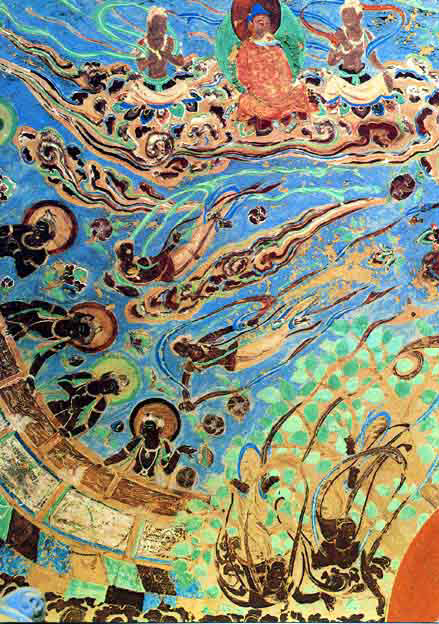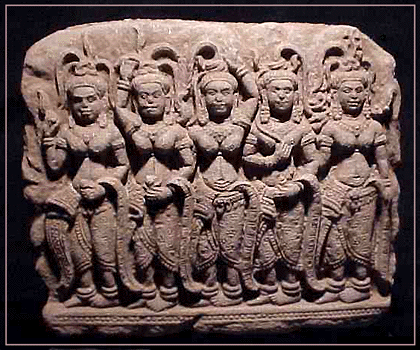
|
|
|
|
BY: SUN STAFF

Apsaras Feb 10, CANADA (SUN) — A serial exploration of the holy sites visited by Lord Caitanya. Pancapsara
In Sri Caitanya-caritamrta Madhya lila 9 we read of Lord Caitanya's travels to Pancapsara-tirtha: Madhya Lila 9 "At the village of Udupi He saw the Gopala Deity installed by Sri Madhvacarya. He then defeated the Tattvavadis in sastric conversation. The Lord next visited Phalgu-tirtha, Tritakupa, Pancapsara, Surparaka and Kolapura."
As we read in yesterday's segment, both Phalgu-tirtha and Tritakupa are located in Belur, Karnataka, while Surparaka is in Maharashtra, near Mumbai. In Srimad-Bhagavatam 10.79.9-21, we read about Lord Balarama's travels, and His visit to Pancapsara Lake: Srimad-Bhagavatam 10.79.9-21 "There at Setubandha (Ramesvaram) Lord Halayudha gave brahmanas ten thousand cows in charity. He then visited the Krtamala and Tamraparni rivers and the great Malaya Mountains. In the Malaya range Lord Balarama found Agastya Rsi sitting in meditation. After bowing down to the sage, the Lord offered him prayers and then received blessings from him. Taking leave from Agastya, He proceeded to the shore of the southern ocean, where He saw Goddess Durga in her form of Kanya-kumari. "Next He went to Phalguna-tirtha and bathed in the sacred Pancapsara Lake, where Lord Visnu had directly manifested Himself. At this place He gave away another ten thousand cows." By the evidence provided in Bhagavatam 10.79.9-21 and that noted in the segment on Tritakupa, there seems to be no question about the fact that Pancapsara-tirtha is located near Belur, Karnataka. In Madhya lila 9.279, Srila Prabhupada provides a detailed story of the pastime for which Pancapsara is famous: Madhya 9.279
"Sri Caitanya Mahaprabhu, the son of mother Saci, next went to Tritakupa, and after seeing the Visala Deity there, He went to the holy place known as Pancapsara-tirtha. PURPORT When the five Apsaras went to break Acyuta Rsi's meditation, they were all chastised and cursed by the saint. As a result, the girls turned into crocodiles in a lake that came to be known as Pancapsara. Lord Ramacandra also visited this place. From Sri Narada Muni's narration, it is understood that when Arjuna went to visit the holy places, he learned about the condemnation of the five Apsaras. He delivered them from their abominable condition, and from that day the lake known as Pancapsara became a place of pilgrimage." Madhya 9.280
"After seeing Pancapsara, Sri Caitanya Mahaprabhu went to Gokarna. While there, He visited the temple of Lord Siva, and then He went to Dvaipayani. Sri Caitanya Mahaprabhu, the crown jewel of all sannyasis, then went to Surparaka-tirtha. PURPORT Surparaka is about twenty-six miles north of Bombay. In the Maharashtra province, near Bombay, is a district known as Thana and a place known as Sopara. Surparaka is mentioned in the Mahabharata (Santi-parva, 41.66-67)." In the Nityananda Charitamrita by Sri Vrindavana Dasa Thakur, we read that Nityananda Prabhu also went on pilgrimage to Pancapsara-tirtha: "Lord Nityananda then visited a monastery where He found them all sitting together. The Lord asked a question, but no one replied. Becoming angry with them, the Lord kicked them in the head. They all simply smiled and ran away. Lord Nityananda thus fearlessly continued His travels through the forest. Lord Nityananda eventually arrived in Kanya-kumari. After seeing Durga there, He went to see the Southern Ocean. He then went to Anantapura and, after that, He went to Pancapsara-kunda. He next visited the temple of Lord Siva known as Gokarna. He visited Kerala and the various places in Trigarta. He also visited goddess Parvati, who dwells on an island near Gokarna." In the book India in Kalidasa by Dr. B.R. Ambedkar (Hyderabad 1947), we get an interesting glimpse of the academic debate on the geographic location of tirthas such as Pancapsara. Reading this, we see how fortunate we are to have the authority of whatever specificity Srila Prabhupada provides in his purports to clarify such matters: "The lake Pancapsara is difficult to identify accurately. The List of Ancient Monuments in the Chota-Nagpur Division locates it in the district of Udayapur, one of the tributary states in Chota-Nagpur. Kapu, Bandhanpur, Banjiamba and Ponri, according to this list, are supposed to be on the site of this lake. But this identification seems hardly correct. It should lie somewhere to the north-cast of Pancavati at a considerable distance from Agastya Asrama. Pancavati is generally identified with Nasik and, according to Kalidasa, the hermitage was situated within the Pancavati itself and must be either Agastipuri, twenty-four miles to the south-east of Nasik, or Akolha to the east of Nasik. Next to the Agastya Asrama but at a considerable distance so as to appeal like the full moon through the clouds lay the lake Pancapsara. It must lie somewhere between the Pancavati, i.e. Nasik and the Citrakuta hill nearer to the former than to the latter as there were certain other localities lying between this lake and the Citrakuta hill according to the description of the poet. We must also remember that it lay at a visible distance from about Nasik (Agastya Asrama) and so must not have been situated very far from there. The identification of the List of Ancient Monuments in the Chota-Nagpur Division cannot hold ground in view of the fact that through its location the lake would not lie between the Pancavati and Citrakuta, or rather the latter would lie between the Pancavati and itself. And it would be an unnecessarily circuitous way to take from Nasik to Ayodhya via Chota-Nagpur even for a possible aircraft. The Bhagavata places it in southern India and the Caitanya Caritamrta at Gokarna, while Sridharasvami would locate it near Phalguna or Anantapura in the Madras Presidency, fifty-six miles to the south-east of Bellary, but none of these identifications seems to be correct as they all lie to the south of the river Godavari, whereas the lake Pancapsara must be placed somewhere to the north of the Godavari as the aerial car has taken a north-easterly direction from Nasik. The lake has been described by the poet, following the tradition of the Ramayana as the pleasure-lake of the sage Satakarni, who, while living on the darbha grass, was enticed into the snare of nymphs by Indra. The sage was supposed to live in a palace under the water of the lake from where the sound of singing and tabor always emanated and was audible outside. This obviously is a traditional reference." As we understand the arguments of Dr. Ambedkar, which take into account the descriptions of Pancapsara's location as given by several bona fide Vaisnava sources (the Bhagavatam, Caitanya-caritamrta and Sridhar Swami), he appears to be in agreement with sastra except insofar as the position of Pancapsara conflicts with the current location of the Godavari. Rivers, of course, are well known to move significant distances over great periods of time.

Apsaras In the Mahabharata, Book 1, Adi Parva, Section 219 of the Arjuna-vanavasa Parva, we find another detailed narrative about the pastime of the five apsaras who were cursed to live as crocodiles, until Arjuna liberated them in Pancapsara Lake: "Vaisampayana said, 'Varga continued, 'We were then, O foremost one of Bharata's race, deeply distressed at this curse. We sought to propitiate that Brahmana of ascetic wealth that departed not from his vow. Addressing him, we said, 'Inflated with a sense of our beauty and youth, and urged by the god of desire, we have acted very improperly. It behoveth thee, O Brahmana, to pardon us! Truly, O Brahmana, it was death to us that we had at all come hither to tempt thee of rigid vows and ascetic wealth. The virtuous, however, have said that women should never be slain. Therefore grow thou in virtue. It behoveth thee not to slay us so. O thou that art conversant with virtue, it hath been said that a Brahmana is ever the friend of every creature. O thou of great prosperity, let this speech of the wise become true. The eminent always protect those that seek protection at their hands. We seek thy protection. It behoveth thee to grant us pardon.' Vaisampayana continued, 'Thus addressed, that Brahmana of virtuous soul and good deeds and equal in splendour, O hero, unto the sun or the moon, became propitious unto them. And the Brahmana said, 'The words hundred and hundred thousand are all indicative of eternity. The word hundred, however, as employed by me is to be understood as a limited period and not indicative of a period without end. Ye shall, therefore, becoming crocodiles, seize and take away men (for only a hundred years as explained by me). At the end of that period, an exalted individual will drag you all from water to the land. Then ye will resume your real forms. Never have I spoken an untruth even in jest. Therefore, all that I have said must come to pass. And those sacred waters (within which I assign you your places), will, after you will have been delivered by that individual, become known all over the world by the name of Nari-tirthas (or sacred waters connected with the sufferings and the deliverance of females), and all of them shall become sacred and sin cleansing in the eyes of the virtuous and the wise.' Vaisampayana continued, 'Varga then addressing Arjuna, finished her discourse, saying, 'Hearing these words of the Brahmana, we saluted him with reverence and walked round him. Leaving that region we came away with heavy hearts, thinking as we proceeded, 'Where shall we all soon meet with that man who will give us back our own shapes (after our transformation)?' As we were thinking of it, in almost a moment, O Bharata, we beheld even the eminent celestial Rishi Narada. Beholding that Rishi of immeasurable energy, our hearts were filled with joy. Saluting him with reverence, O Partha, we stood before him, with blushing faces. He asked of us the cause of our sorrow and we told him all. Hearing what had happened the Rishi said, 'In the low-lands bordering on the southern ocean, there are five regions of sacred water. They are delightful and eminently holy. Go ye thither without delay. That tiger among men, Dhananjaya, the son of Pandu of pure soul, will soon deliver you, without doubt, from this sad plight.' O hero, hearing the Rishi's words, all of us came hither. O sinless one, true it is that I have today been delivered by thee. But those four friends of mine are still within the other waters here. O hero, do a good deed by delivering them also.' Vaisampayana continued, 'Then, O monarch, that foremost of the Pandavas, endued with great prowess, cheerfully delivered all of them from that curse. Rising from the waters they all regained their own forms. Those Apsaras then, O king, all looked as before. Freeing those sacred waters (from the danger for which they had been notorious), and giving the Apsaras leave to go where they chose, Arjuna became desirous of once more beholding Chitrangada. He, therefore, proceeded towards the city of Manipura. Arrived there, he beheld on the throne the son he had begotten upon Chitrangada, and who was called by the name of Vabhruvahana. Seeing Chitrangada once more, Arjuna proceeded, O monarch, towards the spot called Gokarna.'"
| |